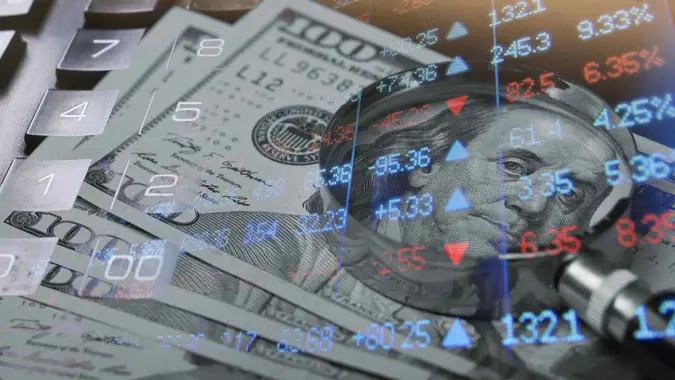How Many Bitcoins Are There?

Commitment to Our Readers
GOBankingRates' editorial team is committed to bringing you unbiased reviews and information. We use data-driven methodologies to evaluate financial products and services - our reviews and ratings are not influenced by advertisers. You can read more about our editorial guidelines and our products and services review methodology.

20 Years
Helping You Live Richer

Reviewed
by Experts

Trusted by
Millions of Readers
If you’ve ever wondered how many bitcoins are there, you’re not alone. Bitcoin’s capped supply of 21 million coins is one of its most famous — and important — features. As of June 2025, over 19.88 million bitcoins have been mined, leaving 1.12 million still to be released into circulation.
But how close is the crypto world to reaching that 21 million cap — and what happens when it’s finally hit? Read on to find out.
Quick Facts: How Many Bitcoins Are There?
- Total bitcoin supply: 21 million
- Bitcoins already mined: 19.88 million
- Bitcoins left to mine: 1.12 million
- Estimated year of last bitcoin mined: 2140
Bitcoin Supply Overview
Bitcoin has a maximum supply of 21 million. As of June 2025, the supply is 19.88 million, all of which is in circulation.
Here are some facts about the bitcoin supply:
- Bitcoin was designed with scarcity in mind, and the supply cap of 21 million was intended to keep inflation from eroding bitcoin’s purchasing power.
- Not all bitcoin is available at once — new bitcoins enter circulation through mining.
- Bitcoin mining is a process that uses powerful computers to solve complex mathematical problems, securing the network while validating transactions.
- This system also prevents double spending, which is the risk of the same bitcoin being used more than once.
How Many Bitcoins Have Been Mined?
As of June 2025, 19.88 million bitcoins have been mined. Here’s how mining works:
- Miners solve complex equations: They use vast amounts of processing power to verify transactions and add the next “block” to the blockchain.
- The blockchain records every transaction: It’s a running log of all bitcoin transactions, adding each new one in a sequence.
- Miners earn block rewards: When a miner successfully adds a block, they receive a reward in the form of newly minted bitcoin.
- The current reward is 3.125 BTC: Each new block currently generates 3.125 new bitcoins.
How Many Bitcoins Are Left To Be Mined?
As of June 2025, there are 1.12 million bitcoins left to be mined.
To incentivize miners to validate transactions, the network offers a block reward to the first miner to successfully verify all transactions in a block. The reward is currently 3.125 BTC.
When bitcoin was first launched, the reward was 50 BTC. However, a process called halving cuts the block reward by half every time 210,000 new blocks are added to the chain.
Since a new block is added roughly every 10 minutes, it takes about four years to reach the next halving point. Experts predict this process will continue until 2140, when the final bitcoin halving will reduce the reward to nearly zero — and the supply of 21 million bitcoins will be fully mined.
Timeline of Bitcoin Halving Events and Rewards
The following table shows how previous halving events slowed the creation of new bitcoin by reducing the reward. You can also see how expected future halving events will continue that process.
| Halving Event | New Reward |
|---|---|
| November 2012 | 25 BTC |
| July 2016 | 12.5 BTC |
| May 2020 | 6.25 BTC |
| April 2024 | 3.125 BTC |
| 2028 | 1.5625 BTC |
| 3032 | 0.78125 BTC |
| 2036 | 0.390625 BTC |
| 2040 | 0.1953125 BTC |
| 2048 | 0.09765625 BTC |
| 2052 | 0.048828125 BTC |
| 2056 | 0.0244140625 BTC |
| 2060 | 0.01220703125 BTC |
If this continues, the reward will be halved to 0.00000001 in 2140, signifying that all bitcoins have been mined.
What Happens When There Are No Bitcoins Left To Mine?
Even after all bitcoin has been mined, transactions will continue to be processed on the blockchain and miners will continue to verify them. However, miners likely will receive processing fees instead of newly minted bitcoin as a reward, according to the Blockchain Council.
If bitcoin is sufficiently valuable by the time all the bitcoins have been mined, transaction fees may pay enough to incentivize miners to continue running power-intensive mining computers. If they don’t, some experts say bitcoin prices could fall, and the networks could be less secure.
But the network has a built-in safeguard against that happening.
It’s designed to keep the time it takes to create a new block at about 10 minutes. It does that by adjusting the difficulty of mining a block according to the number of miners. The more miners there are, the harder and more resource-intensive mining becomes. Miners who aren’t making money drop out, making it easier and cheaper for successful miners to keep mining.
How Much Bitcoin Is Lost?
Analysts’ estimates of the number of lost bitcoins range from 2.3 million to 3.7 million, according to Ledger. However, it’s impossible to know for sure. And the figure depends in part on how you define “lost.”
A broad definition would include bitcoin that is accounted for and accessible but will never be traded or spent. Bitcoin creator Satoshi Nakamoto’s holdings are thought to fall into this category.
A narrower definition would only include coins that are locked up for one of a variety of reasons, such as:
- The owner lost the security key to the digital wallet where the coins are stored on their hard drive
- The computer files associated with the key were deleted or destroyed
- The hard drive itself was disposed of or destroyed
Cryptocurrency lost this way is not retrievable — an important thing to remember if you invest in bitcoin.
Lost bitcoin makes the cryptocurrency more scarce by effectively reducing the number of coins that can be traded.
Who Owns the Most Bitcoin?
Roughly 75% of bitcoin is held by individual investors. The rest is held by companies, funds and governments. Microstrategy is the largest holder overall, with 592,100 coins — 2.82% of the total supply, according to BitcoinTreasuries.net.
Estimated top individual holders, per the crypto exchange Kraken, include:
- Satoshi Nakamoto: 1.1 million BTC
- The Winklevoss Twins: 70,000 BTC
- Tim Draper: 29,500 BTC
- Michael Saylor: 17,732 BTC
These are all estimates, but each owns over $1 million in BTC.
Keep In Mind
Bitcoin’s price tends to experience increased volatility around halving events, which happen about every four years. The current block reward is 3.125 BTC, but it’s set to drop to 1.5625 BTC after the next halving in March 2028.
Why Bitcoin’s Limited Supply Matters for Investors
Limited supply creates scarcity, which drives demand. Scarcity also protects bitcoin’s deflationary characteristics by preventing the release of too many coins into the economy. Just as with fiat currency, overabundance would reduce bitcoin’s purchasing power.
Bitcoin’s 21 million coin limit also makes the system more secure by incentivizing miners to verify transactions. Ultimately the limited supply of bitcoin increases demand, which drives up the price for each bitcoin. This is why investors expect the price of bitcoin to continue trending upward over time.
Bitcoin FAQ: How Many Bitcoins Are There and More
Curious about the total bitcoin supply or how mining works? Here are quick answers to some of the most common questions.- How many bitcoins are left to mine?
- As of June 2025, 1.12 million bitcoins are left to mine.
- How many bitcoins have been mined?
- Of the 21 maximum supply of bitcoins, 19.88 million have been mined.
- Why is there only 21 million bitcoin?
- The limit creates scarcity, which drives demand and potentially increases prices.
- What if you invested $1,000 in bitcoin 10 years ago?
- Bitcoin traded for $244.28 on June 23, 2015. A $1,000 investment would've bought you 4.46 coins. At the current price of $104,070, the coins would be worth about $464,152.
- How much would $100 dollars in bitcoin be worth today?
- One hundred dollars worth of bitcoin purchased 10 years ago would be worth about $46,415 today.
- Will bitcoin reach $1 billion?
- There's no way to know. Predictions about future bitcoin prices are purely speculative.
Jacob Wade and David Granahan contributed to the reporting for this article.
Information is accurate as of June 20, 2025.
Our in-house research team and on-site financial experts work together to create content that’s accurate, impartial, and up to date. We fact-check every single statistic, quote and fact using trusted primary resources to make sure the information we provide is correct. You can learn more about GOBankingRates’ processes and standards in our editorial policy.
- Binance Academy. 2022. "What Is Tokenomics and Why Does It Matter?"
- Business Insider. 2022. "Bitcoin halving is how the supply of the world's largest cryptocurrency is controlled."
- GFinity. 2022. "Does Ethereum have a cap?"
- Bloomberg. 2023. "Bitcoin ‘Halving’ Due Next Year Spurs Predictions of Rally in Token Past $50,000."
- Blockchain Council. 2023. "How Many Bitcoins Are There And How Many Are Left To Mine?"
- Cointelegraph. "Bitcoin vs. satoshi: Key differences explained."
- CoinMarketCap. "Bitcoin."
- Bitcoin Treasuries. "Bitcoin Treasuries."
- Bitbo. "How Many Bitcoins Are There?"
- Kraken. 2025. "Who owns the most Bitcoin?"
- Bitcoinblockhalf. "Bitcoin Block Reward Halving Countdown."
- Cointelegraph. 2025. "93% of all Bitcoin is already mined. Here’s what that means."
- Blockpit. 2025. "Bitcoin Halving Explained: What Investors Need to Know [2025]."
- River. "What Happens to Lost Bitcoin?"
 Written by
Written by  Edited by
Edited by 

























